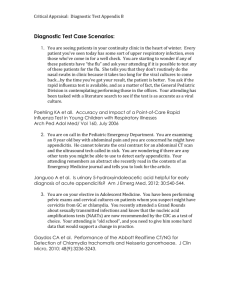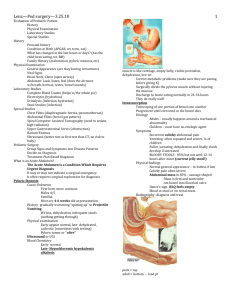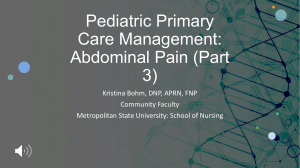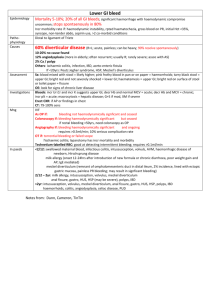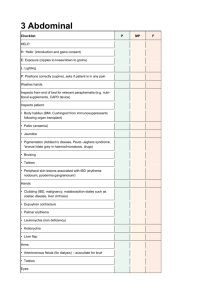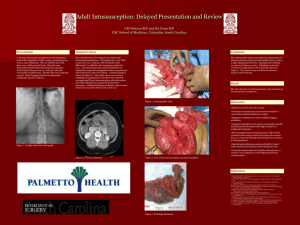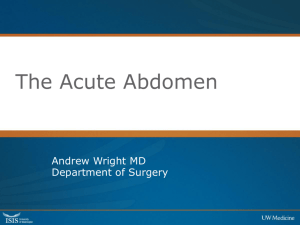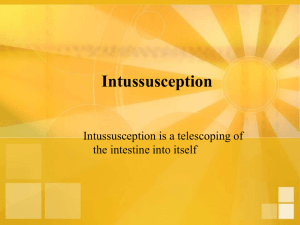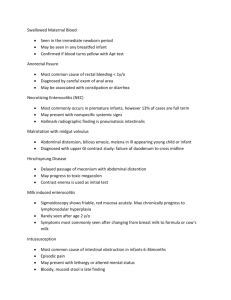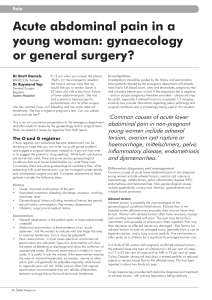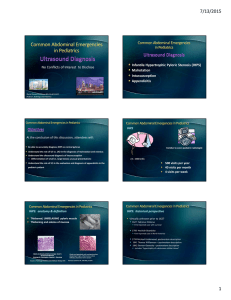ABDOMINAL PAIN in the PEDIATRIC PATIENT Tim Weiner, M.D. Dept. of Surgery
advertisement
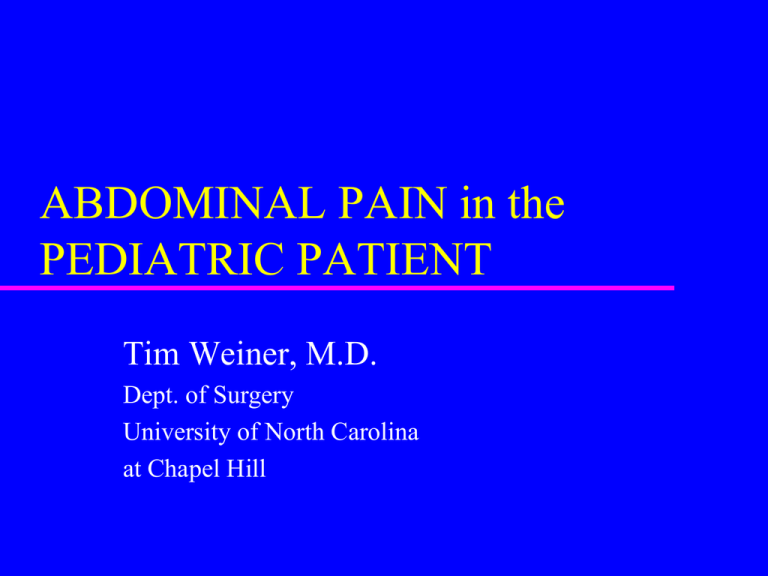
ABDOMINAL PAIN in the PEDIATRIC PATIENT Tim Weiner, M.D. Dept. of Surgery University of North Carolina at Chapel Hill In General Common problems occur commonly – intussusception in the infant – appendicitis in the child The differential diagnosis is age-specific In pediatrics most belly pain is non-surgical – “Most things get better by themselves. Most things, in fact, are better by morning.” Bilous emesis in the infant is malrotation until proven otherwise A high rate of negative tests is OK The History Pain (location, pattern, severity, timing) – pain as the first sx suggests a surgical problem Vomiting (bile, blood, projectile, timing) Bowel habits (diarrhea, constipation, blood, flatus) Genitourinary complaints Menstrual history Travel, diet, contact history Diagnosis by Location biliary hepatitis appendicitis enteritis/IBD ovarian gastroenteritis early appendicitis PUD pancreatitis non-specific colic early appendicitis constipation UTI pelvic appendicitis spleen/EBV constipation non-specific ovary The Physical Examination Warm hands and exam room Try to distract the child (talk about pets) A quiet, unhurried, thorough exam Plan to do serial exams Do a rectal exam The Abdominal Examination breath sounds Murphy’s sign “sausage” breath sounds spleen edge Dance’s sign rebound tender at McBurney’s point cecal “squish” constipation Rovsing’s sign hernias torsion Relevant Physical Findings Tachycardia Alert and active/still and silent Abdominal rigidity/softness Bowel sounds Peritoneal signs (tap, jump) Signs of other infection (otitis, pharyngitis, pneumonia) Check for hernias Blood in the Stool Newborn – ingested maternal blood, formula intolerance, NEC, volvulus, Hirschsprung’s Toddler – anal fissures, infectious colitis, Meckel’s, milk allergy, juvenile polyps, HUS, IBD 2 to 6 years – infectious colitis, juvenile polyps, anal fissures, intussusception, Meckel’s, IBD, HSP 6 years and older – IBD, colitis, polyps, hemorrhoids Blood in the Vomitus Newborn – ingested maternal blood, drug induced, gastritis Toddler – ulcers, gastritis, esophagitis, HPS 2 to 6 years – ulcers, gastritis, esophagitis, varices, FB 6 years and older – ulcers, gastritis, esophagitis, varices Further Work-up CBC and differential Urinalysis X-rays (KUB, CXR) US Abdominal CT Stool cultures Liver, pancreatic function tests (Rehydrate, ?antibiotics, ?analgesiscs) Relevant X-ray Findings Signs of obstruction – air/fluid levels – dilated loops – air in the rectum? Fecalith Paucity of air in the right side Constipation Operate NOW Vascular compromise – – – – – malrotation and volvulus incarcerated hernia nonreduced intussusception ischemic bowel obstruction torsed gonads Perforated viscus Uncontrolled intra-abdominal bleeding Operate SOON Intestinal obstruction Non-perforated appendicitis Refractory IBD Tumors Appendicitis Common in children; rare in infants Symptoms tend to get worse Perforation rarely occurs in the first 24 hours The physical exam is the mainstay of diagnosis Classify as simple (acute, supparative) or complex (gangrenous, perforated) Incidental Appendectomy Can be done by inversion technique Absolute indication – Ladd’s procedure Relative indications – – – – – – Hirschsprung’s pullthrough Ovarian cystectomy Intussusception Atresia repair Wilms’ tumor excision CDH Intussusception Typically in the 8-24 month age group Diagnosis is historical – intermittent severe colic episodes – unexplained lethargy in a previously healthy infant Contrast enema is diagnostic and often therapeutic Post-op small bowel intussusception The “Medical Bellyache” Pneumonia Mesenteric adenitis Henoch-Schonlein Purpura Gastroenteritis/colitis Hepatitis Swallowed FB Porphyria Functional ileus UTI Constipation IBD “flare” rectus hematoma Laparoscopy Diagnosis – – – – – non-specific abdominal pain chronic abdominal pain female patients undescended testes trauma Treatment – – – – – appendicitis Meckel’s diverticulum cholecystitis ovarian detorsion/excision lysis of adhesions The Neurologically Impaired Patient The physical exam is important for nonverbal patients The history is important for the spinal cord dysfunction patient Close observation and complementary imaging studies are necessary The Immunologically Impaired Patient A high index of suspicion for surgical conditions and signs of peritonitis may necessitate operation – perforation – uncontrolled bleeding – clinical deterioration Blood product replacement is essential Typhlitis should be considered; diagnosis is best established by CT The Teenage Female Menstrual history – regularity, last period, character, dysmenorrhea Pelvic/bimanual exam with cultures Pregnancy test/urinalysis US Laparoscopy Differential diagnosis – mittelschmerz, PID, ovarian cyst/torsion, endometriosis, ectopic pregnancy, UTI, pyelonephritis In Summary “My dear surgeon, beware- haste not, Pleads the child silently, Listen to my mother, and thenExamine and again examine me: This will improve my lot And assure you accuracy.”
